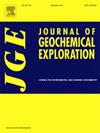Ore-forming process and fluid development at Nanpo Au deposit, Luang Prabang-Loei Belt (NW Laos): Evidence from H-O-S-Pb isotopes and inclusions
IF 3.3
2区 地球科学
Q1 GEOCHEMISTRY & GEOPHYSICS
引用次数: 0
Abstract
The Luang Prabang-Loei tectonic belt, as a significant polymetallic metallogenic belt within the Southeast Asian Tethys tectonic domain, hosts numerous gold deposits. However, the current understanding of the genetic types and mineralization processes of these gold deposits remains insufficient, which restricts the advancement of regional metallogenic theories. This study focuses on the newly discovered large-scale Nanpo gold deposit in this metallogenic belt. By systematically conducting analyses of ore deposit geological characteristics, fluid inclusion testing, and H-O-S-Pb isotope analyses, it aims to reveal the sources of ore-forming materials, clarify the properties and evolutionary patterns of ore-forming fluids, and further elucidate the genetic mechanism and the process of mineralization of the deposit. The orebodies of the Nanpo gold deposit typically have lenticular, stratoid, and veined shapes, which are clearly controlled by ductile shear zones. The ores are mainly of two types: quartz vein type and altered rock type. Based on the interpenetrating relationship of veins and the symbiotic assembly of minerals, the metallogenic process of the Nanpo gold deposit can be divided into three stages: (I) quartz-sericite-gold-poor pyrite stage, (II) quartz-polymetallic sulphide stage, and (III) quartz-carbonate mineral stage. With the help of studies on fluid inclusion petrography, microscopic thermometry and laser Raman spectroscopy, it can be found that there are three main types of fluid inclusions in the deposit, namely, NaCl-H2O, NaCl-CO2-H2O and pure CO2. In general terms, they are part of a NaCl - H2O - CO2 ± CH4 ± N2 low-temperature to intermediate-temperature/low-salinity fluid system. Using the isotopes S-Pb can be seen, the ore - forming materials come to a large extent from the homogenized lower crust - upper mantle. The H - O isotopes suggest that the ore - forming fluids were of metamorphic water which had an affinity to meteoric waters in the later stage. These evidences suggest that the Nanpo gold deposit is a typical orogenic gold deposit, and its formation is closely associated with the collisional orogeny in Indo - China block after the Paleo — Tethys closed. This study provides a theoretical foundation for the advancement of regional metallogenic theories and offers guidance for regional mineral exploration.
老挝琅勃拉邦-洛伊带南坡金矿成矿过程与流体发育:来自H-O-S-Pb同位素和包裹体的证据
Luang Prabang-Loei构造带是东南亚特提斯构造域中重要的多金属成矿带,拥有大量金矿床。然而,目前对这些金矿床的成因类型和成矿过程认识不足,制约了区域成矿理论的发展。本文以该成矿带新发现的大型南坡金矿床为研究对象。系统开展矿床地质特征分析、流体包裹体测试、H-O-S-Pb同位素分析,揭示成矿物质来源,明确成矿流体性质及演化模式,进一步阐明矿床的成因机制和成矿作用过程。南坡金矿床矿体具有典型的透镜状、层状和脉状矿体,明显受韧性剪切带控制。矿石主要为石英脉型和蚀变岩型两种类型。根据矿脉互穿关系和矿物共生组合,将南坡金矿床成矿过程划分为3个阶段:(1)石英—绢云母—贫金黄铁矿阶段、(2)石英—多金属硫化物阶段和(3)石英—碳酸盐矿物阶段。通过流体包裹体岩石学、显微测温和激光拉曼光谱研究发现,矿床中流体包裹体主要有3种类型,分别为NaCl-H2O、NaCl-CO2-H2O和纯CO2。一般来说,它们是NaCl - H2O - CO2±CH4±N2低温到中温/低盐度流体体系的一部分。利用S-Pb同位素可以看出,成矿物质在很大程度上来自均质化的下地壳-上地幔。氢氧同位素表明成矿流体为变质水,后期与大气水有亲缘关系。这些证据表明,南坡金矿床是典型的造山带型金矿床,其形成与古特提斯闭合后印支地块的碰撞造山作用密切相关。该研究为区域成矿理论的发展提供了理论基础,对区域矿产勘查具有指导意义。
本文章由计算机程序翻译,如有差异,请以英文原文为准。
求助全文
约1分钟内获得全文
求助全文
来源期刊

Journal of Geochemical Exploration
地学-地球化学与地球物理
CiteScore
7.40
自引率
7.70%
发文量
148
审稿时长
8.1 months
期刊介绍:
Journal of Geochemical Exploration is mostly dedicated to publication of original studies in exploration and environmental geochemistry and related topics.
Contributions considered of prevalent interest for the journal include researches based on the application of innovative methods to:
define the genesis and the evolution of mineral deposits including transfer of elements in large-scale mineralized areas.
analyze complex systems at the boundaries between bio-geochemistry, metal transport and mineral accumulation.
evaluate effects of historical mining activities on the surface environment.
trace pollutant sources and define their fate and transport models in the near-surface and surface environments involving solid, fluid and aerial matrices.
assess and quantify natural and technogenic radioactivity in the environment.
determine geochemical anomalies and set baseline reference values using compositional data analysis, multivariate statistics and geo-spatial analysis.
assess the impacts of anthropogenic contamination on ecosystems and human health at local and regional scale to prioritize and classify risks through deterministic and stochastic approaches.
Papers dedicated to the presentation of newly developed methods in analytical geochemistry to be applied in the field or in laboratory are also within the topics of interest for the journal.
 求助内容:
求助内容: 应助结果提醒方式:
应助结果提醒方式:


